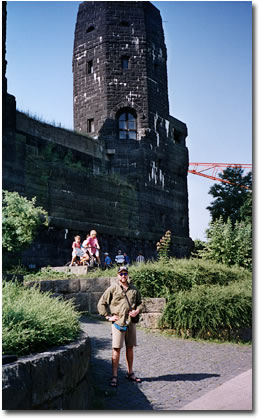|
|
 |
 |
|
|
| 9th
Infantry Division — World
War II — Remagen, Germany |
|
|
|
 |
 |
 |
 |
 |
 |
 |
|
Vincent
Z. Whaley visited the remains
of the Ludendorff Bridge in
July 1995. His grandfather,
Starlin H. Hughes, served
with the 47th Infantry Regiment,
9th Infantry Division, during
World War II.
|
DISTINGUISHED
UNIT CITATION, from Eight Stars
to Victory: A History of the Veteran
Ninth U.S. Infantry Division:
The 47th Infantry Regiment with the
following attached units:
84th Field Artillery Battalion;
Company B, 9th Medical Battalion;
Company B, 15th Engineer Battalion;
Company A, 746th Tank Battalion;
Company C, 899th Tank Destroyer Battalion;
These units distinguished themselves
by extraordinary heorism and outstanding
performance of duty in gallantly holding
and extending the important Remagen
bridgehead over the Rhine River in
Germany from 8 to 19 March 1945.
The 47th Infantry Regiment, and attached
units, were ordered on 7 March 1945
to cross the Ludendorff Bridge over
the Rhine, which had been seized intact
by elements of the 9th Armored Division.
The 2nd Battalion, 47th Infantry Regiment,
arrived at Remagen early on 8 March
and immediately crossed the river.
Committed to action at once, it passed
through Orsberg and attacked toward
Bruchausen, where all resistance was
overcome. The remainder of the regiment
moved swiftly across the river during
the day. The 1st Battalion seized
Scheuren and the 3rd Battalion took
Ohlenberg, where some of the stiffest
resistance in the bridgehead was developed
by tanks, self-propelled guns and
well-organized enemy infantry.
All battalions were immediately counterattacked,
but these savage thrusts by the enemy
were smashed after bitter fighting.
Committed in the center of the bridgehead,
the 47th Infantry Regiment was the
first complete infantry regiment to
cross the Rhine River. It was to maintain
its foothold and attack to the east,
northeast and southeast to deepen
the vital bridgehead and protect the
extremely important Ludendorff crossing.
The infuriated enemy, who by this
time had recovered from the initial
surprise of the crossing, reacted
savagely to the thrust of Germany.
On 9 March, the regiment continued
the attack eastward against the violent
resistance of a determined enemy,
amply supported by artillery, tanks,
and self-propelled guns. Each gain
was subject to numerous counterattacks.
Integrated enemy units including the
11th Panzer Division were thrown at
the bridgehead, and they concentrated
much of their power in the center
against the 47th Infantry Regiment.
Although constant enemy counterattacks
made rest impossible, the regiment
slowly but surely cut its way forward
over the hilly, wooded terrain. Infantrymen
destroyed tanks, captured guns, overran
antiaircraft guns, and by 16 March,
had forced the enemy out of Notscheid,
after bloody house-to-house fighting.
Allowing the Germans no time for rest,
the regiment continued attacking and
took Vettelschoss, building by building,
and pressed courageously forward against
ever increasing resistance to seize
Hohnet.
Finally, the autobahn was reached
and the intial bridgehead line attained.
As the keystone in the arch of the
Remagen bridgehead, this gallant force
had advanced 12,000 yards in 12 days
against great odds. It had pitted
its strength, its fortitude and its
bitterly earned combat experience
against a desperate, aggressive and,
at times, a numerically superior enemy,
and, by cool courage, driving force
and utter disregard for personal safety,
had sustained and expanded the Remagen
bridgehead on the east side of the
Rhine River.
The determination and indomitable
spirit of the courageous officers
and men of the 47th Infantry Regiment,
with attached units, exemplify the
finest traditions of the military
service.
[ Back
to Photographs • Previous
Photograph ]
|
 |
 |
 |
|
|
 |
|
 |
|
|
|
|
|
|
|
|
|